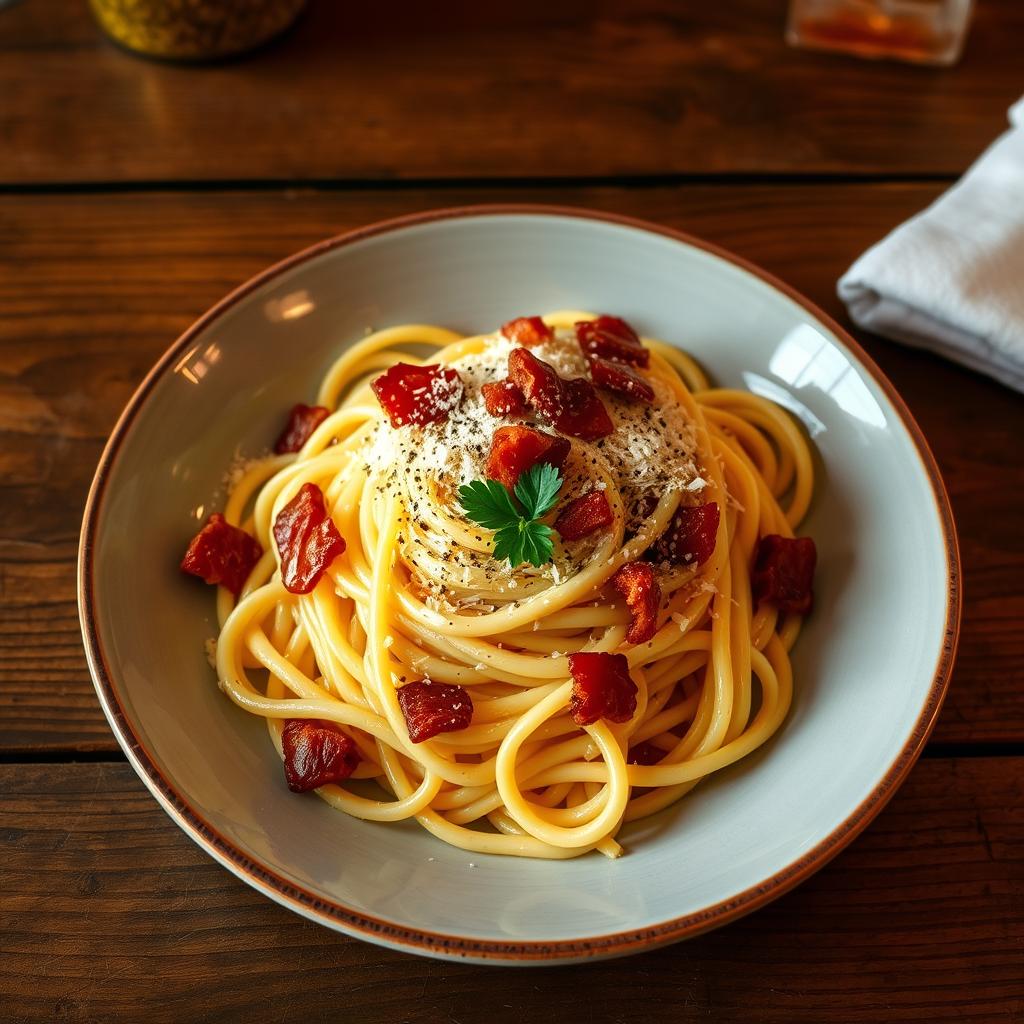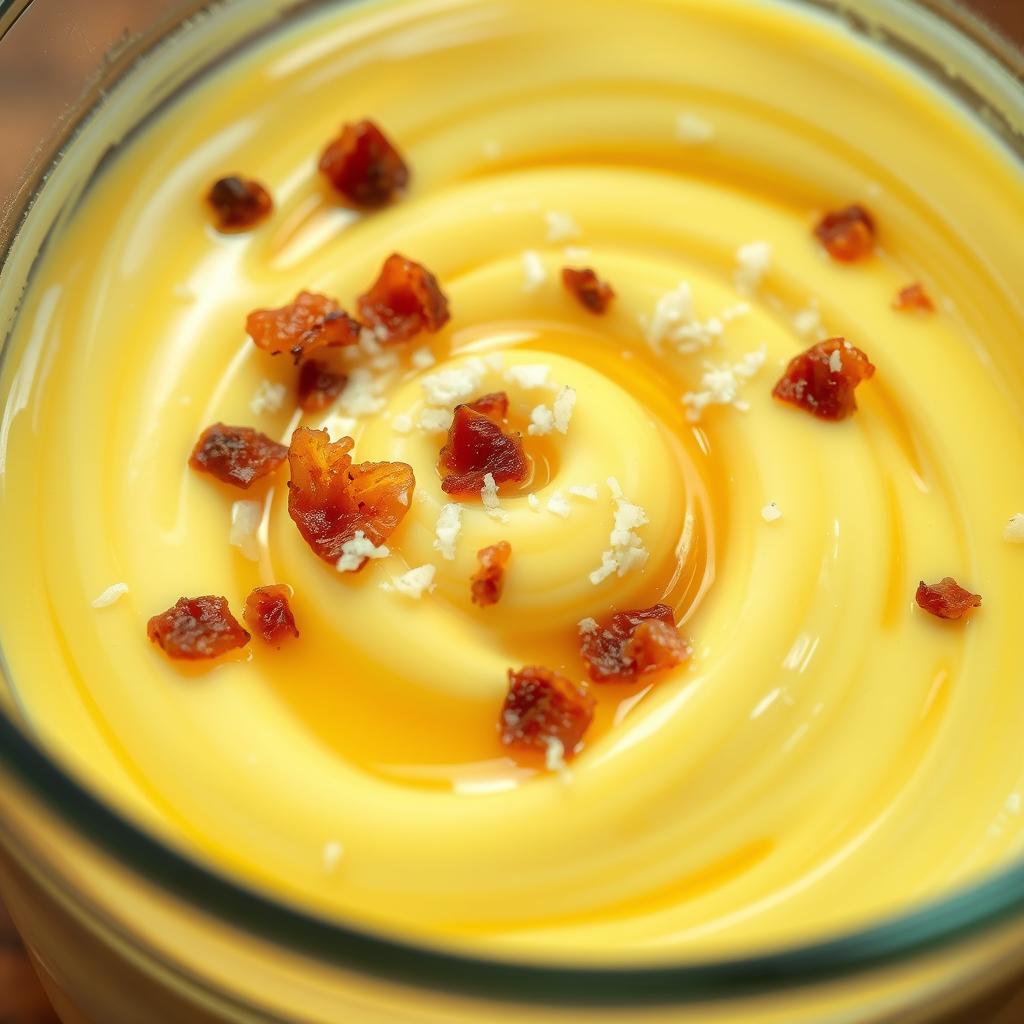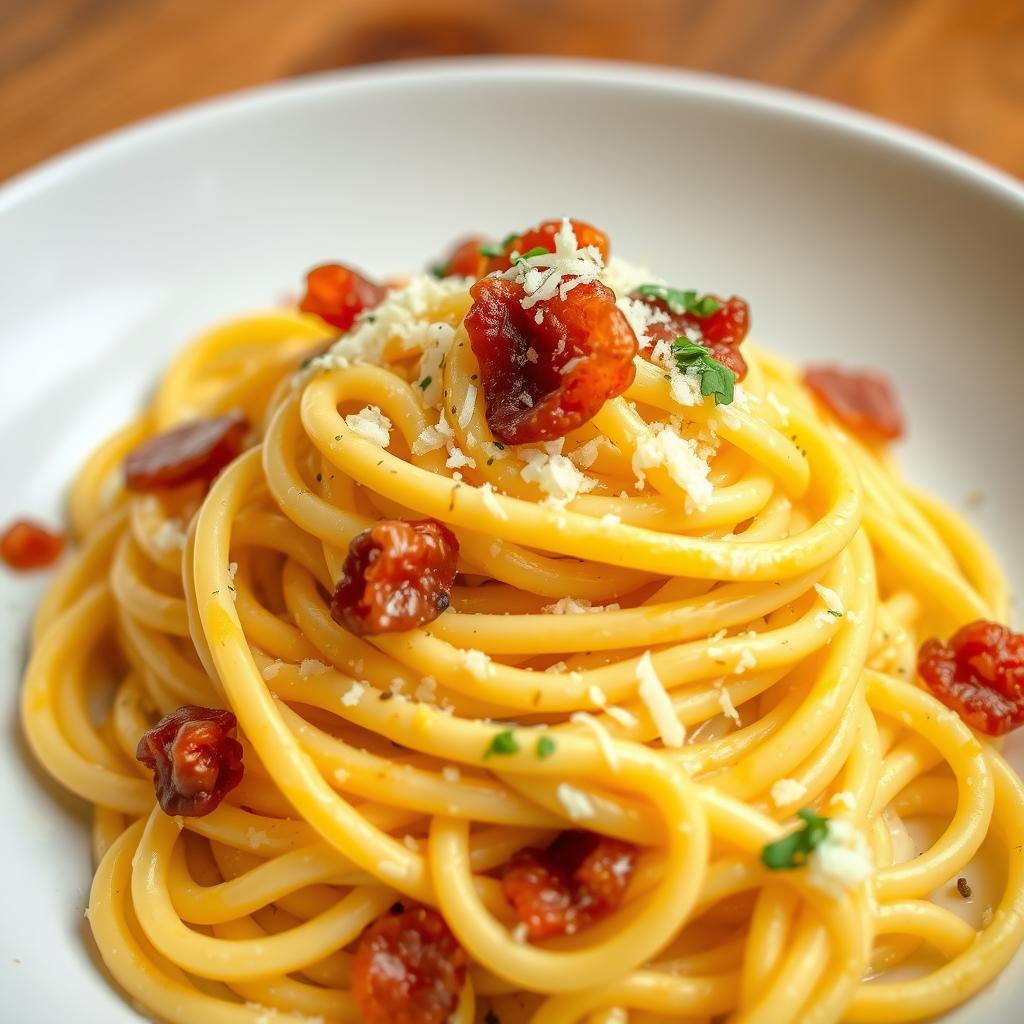The smell of sizzling bacon brings back memories of my grandmother’s kitchen. Sunday dinners at her Italian eatery were special. Her creamy spaghetti carbonara was always the main attraction.
The dish had a rich, eggy sauce, tender pasta, and crisp bacon. It was a flavor explosion that made my taste buds dance with joy.
Now, as an adult, I often crave that comforting dish. It’s no surprise why – spaghetti carbonara is loved worldwide. Its simple ingredients and perfect texture make it a true Italian classic.

Key Takeaways
- Spaghetti Carbonara is a classic Italian pasta dish made with eggs, crisp bacon or guanciale, and a blend of Pecorino Romano and Parmesan cheese.
- The dish originated in Rome and has evolved into a global favorite, known for its rich, salty, and addictive taste.
- The recipe features a creamy sauce without heavy cream, making it a comforting yet light pasta dinner.
- Spaghetti Carbonara can be prepared in about 30 minutes, making it a perfect weeknight meal.
- The dish is best served immediately for the perfect texture and flavor.
The History and Origins of Carbonara
The beloved Italian dish, Carbonara, has its roots in post-World War II Rome. The name “carbonara” comes from “charcoal burner,” sparking many theories. Some say it was a favorite of Italian charcoal workers, while others believe it was enjoyed by secret societies.
Carbonara has grown from a simple meal to a worldwide favorite. The first mention of “Spaghetti alla Carbonara” was in 1950 in La Stampa. Before that, Roman poet Trilussa was said to have loved it. By 1951, the film “Cameriera bella presenza offresi” even mentioned it.
Evolution into a Global Favorite
The dish’s fame kept growing. The first U.S. recipe for Pasta Carbonara was in Chicago in 1952. It was in “Vittles and Vice.” Then, in 1954, an Italian magazine, “La Cucina Italiana,” published a recipe with pancetta, gruyere, and garlic.
Traditional vs Modern Interpretations
Over time, Carbonara recipes have changed. Some now include cream and garlic. The first written recipes of Carbonara were in the 1940s. But, mentions of egg and pasta go back to 1773.
The modern version of Carbonara was first written about in August 1954. It was in La cucina italiana, with spaghetti, egg, pancetta, gruyere, and garlic.
Today, Carbonara is a key part of Roman cuisine and Italian food culture. Its rich history and culinary history make it loved worldwide.
Essential Ingredients for Authentic Carbonara
Making a real spaghetti carbonara needs a few key ingredients. At its core are guanciale (salt-cured pork cheek), Pecorino Romano and/or Parmesan cheese, eggs, and black pepper. You can also use homemade fresh pasta for a special touch.
If you can’t find guanciale, thick-cut bacon is a good alternative. Grate the cheese fresh for the best taste and melting. Mixing Pecorino Romano and Parmesan adds depth and balance.
“Carbonara is all about the quality of the ingredients – you can’t skimp on the pork or the cheese.” – Chef Massimo Bottura
With these ingredients, you’re ready to make a delicious spaghetti carbonara. It will take you straight to Rome with every bite.
The secret to a great carbonara is using the freshest ingredients. Choose top-notch guanciale, Pecorino Romano, Parmesan cheese, and fresh pasta. This will make your dish unforgettable.
Spaghetti Carbonara with Parmesan and Bacon
Spaghetti carbonara is a beloved Italian pasta dish loved by many around the world. It’s made with fresh egg pasta, which makes it even more special. The debate over bacon versus guanciale is fierce, but it’s all about what you like best.
Both options are great, but the key is the cheese. A mix of Pecorino Romano and Parmesan cheese is crucial for the sauce.
Choosing the Right Pasta Type
Dried spaghetti is traditional, but fresh egg pasta adds a velvety texture. It pairs beautifully with the creamy cheese sauce, making it a treat to eat.
Bacon vs. Guanciale Debate
The choice between bacon and guanciale is a big deal for some. Guanciale gives a richer taste, true to the dish’s Roman roots. But good bacon can be just as tasty, especially if guanciale is hard to find.
The Perfect Cheese Blend
The sauce’s success depends on the cheese mix. A 50/50 blend of Pecorino Romano and Parmesan is perfect. It offers the right balance of flavors, making the sauce authentic and satisfying.
| Ingredient | Amount |
|---|---|
| Bacon or Pancetta | 4 slices (125 grams) |
| Eggs | 4 large |
| Parmesan or Pecorino Cheese | 1/4 cup grated |
| Spaghetti | 350 grams |
| Pasta Water | 1 cup reserved |
“A harmonious blend of Pecorino Romano and Parmesan cheese is essential for creating the perfect carbonara sauce.”
The Science Behind the Perfect Carbonara Sauce
The creamy carbonara sauce is a true marvel of culinary science. It’s made by mixing hot pasta water with the noodles’ starch. This creates a smooth, rich sauce for the spaghetti. The trick is to keep the temperature just right to prevent the eggs from scrambling.
The sauce’s secret is a 2:1 ratio of egg yolks to whole eggs. This mix gives the sauce the right balance of richness and texture. It makes sure the sauce sticks to the noodles without being too heavy.

When the hot pasta meets the egg mixture, the starch and emulsifying properties of the egg blend perfectly. The Maillard reaction from cooking the guanciale or pancetta adds a deep flavor. Adding Pecorino Romano cheese, with its high casein content, helps the sauce come together smoothly.
“The key to a perfect carbonara is in the delicate balance of the egg emulsion and the starch from the pasta. It’s a dance of science and culinary artistry.”
Knowing the science behind the carbonara sauce helps chefs and home cooks make it perfectly every time. It’s a dish that’s both indulgent and satisfying.
Step-by-Step Cooking Process
Making the perfect Spaghetti Carbonara is an art. It needs precise cooking and attention to detail. Each step is key to getting that creamy, indulgent texture.
Preparing the Base
Begin by cooking the guanciale (or bacon) in a skillet until it’s crispy. Remove the meat and keep the flavorful fat in the skillet. This fat is the base of the sauce, adding a rich aroma.
Tempering the Eggs
In another bowl, mix the eggs and Parmesan cheese. The secret to a smooth sauce is tempering the eggs right. Add hot pasta water to the egg mix, whisking constantly to cook the eggs gently.
Final Assembly Technique
Drain the spaghetti and save some cooking water. Add the pasta to the skillet with the pork fat. Toss well to coat the pasta evenly. Then, remove the skillet from the heat.
Pour the egg mix over the pasta and toss until the sauce sticks to the noodles. If it’s too thick, add some pasta water. This makes the sauce creamy.
Finally, top the Spaghetti Carbonara with crispy guanciale and Parmesan cheese. Serve it hot. The hot pasta and egg mix create a silky sauce that coats every strand.
Common Mistakes to Avoid
Spaghetti Carbonara is a beloved Italian classic, but it can be tricky to perfect. Avoid these common cooking errors to ensure your carbonara is a triumph every time.
- Using cold ingredients: Ensure all your ingredients, from the eggs to the cheese, are at room temperature before you begin. This helps them incorporate smoothly into the dish.
- Overcooking the pasta: Overcooking the pasta is a surefire way to ruin the texture of your carbonara. Cook the spaghetti to a perfect al dente for the best results.
- Scrambling the eggs: The egg mixture is the key to a creamy carbonara sauce. Be careful not to scramble the eggs when adding them to the hot pasta. Tempering the eggs is essential.
- Adding cream: Authentic carbonara does not contain cream. Rely on the emulsion of pasta water, eggs, and cheese to achieve the desired creaminess.
Proper timing and temperature control are vital when preparing this dish. By avoiding these common cooking errors, you’ll be well on your way to carbonara troubleshooting and mastering those pasta tips.

“The key to a perfect carbonara is in the technique, not the ingredients.”
Tips for Achieving the Creamiest Texture
Making the perfect creamy pasta recipes like spaghetti carbonara is all about temperature and pasta water. These two things are key to a creamy, smooth sauce that sticks to the noodles well.
Temperature Control
To avoid a gritty sauce, keep the temperature right. Warm your bowls in a low oven (around 200°F) before serving. This keeps the sauce creamy and velvety as you mix it with the pasta. It makes the egg yolks and cheese blend perfectly, just like in a Roman trattoria.
Pasta Water Management
Managing pasta water is also crucial for a creamy carbonara. Save a lot of starchy, hot water before draining the noodles. When mixing the pasta with the egg-cheese, add the pasta water slowly. Stir well to make a smooth sauce that sticks to the noodles without drying out.
With these pasta sauce techniques, you’ll make a spaghetti carbonara that’s truly Italian. It’s rich, velvety, and perfectly coated in a creamy sauce. Your guests will definitely want more.
Creative Variations and Add-ins
The traditional spaghetti carbonara recipe is a classic, but it can also be made in many creative ways. Adding minced garlic can make the dish smell amazing. Red pepper flakes can add a bit of heat.
Adding seasonal vegetables like peas or sautéed mushrooms can make the dish more interesting. They add texture and balance out the richness.
Some recipes suggest adding a little butter for extra creaminess. However, some might say this changes the dish too much. Adding grilled chicken can make the dish more filling and add protein.
Carbonara has become a favorite dish around the world. Chefs love to add their own twist to it. For example, Matt Jennings in Boston mixes it with spaghetti alle vongole. Others add sun-dried tomatoes for sweetness and acidity.